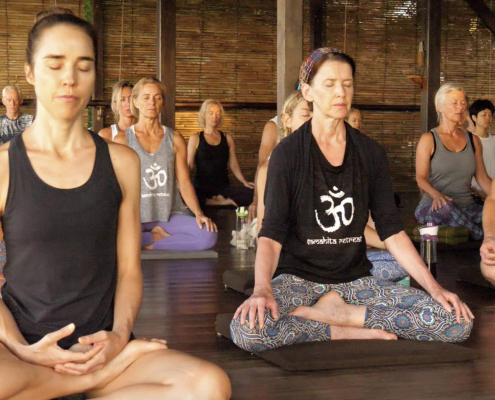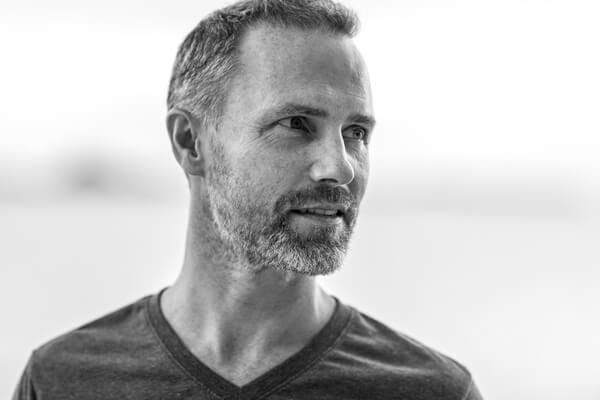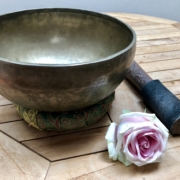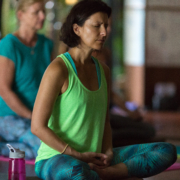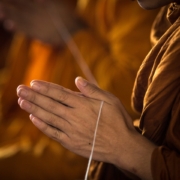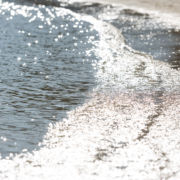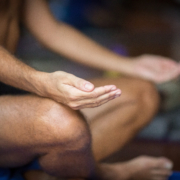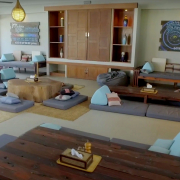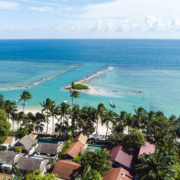 https://samahitaretreat.com/wp-content/uploads/2024/03/DJI_20231220135922_0003_D-scaled.jpg
1920
2560
Kirsten Mia
http://samahitaretreat.com/wp-content/uploads/2024/01/samahita-logo-v2.svg
Kirsten Mia2024-03-20 15:30:592024-03-20 15:30:59Travel, explore, be curious!
https://samahitaretreat.com/wp-content/uploads/2024/03/DJI_20231220135922_0003_D-scaled.jpg
1920
2560
Kirsten Mia
http://samahitaretreat.com/wp-content/uploads/2024/01/samahita-logo-v2.svg
Kirsten Mia2024-03-20 15:30:592024-03-20 15:30:59Travel, explore, be curious!Non-behavioral approaches versus yogic self-awareness in pandemic stress
PART TWO: drugs, infrastructure, and yogic self-awareness
Yoga, Breath and COVID-19: lifestyle behavioral support mechanisms. Approaches to manage the physical and psychological burden of stress from living through and after the current global pandemic
A. Non-Behavioral Approaches Dominate the Literature
- Inflammation Mitigating Drugs and Vaccine Trials
Howard Hughes investigator Vogelstein and colleagues at Johns Hopkins are one of the first to trial a drug approach, in this case using the alpha-1 adrenergic receptor antagonist (1), to mitigate symptoms of inflammation before a full blown cytokine response takes place (2). Meanwhile in the ongoing confusion around the efficacy of certain drugs a major journal’s publication on May 22, 2020, concluding chloroquine an antimalarial drug and its analog, hydroxychloroquine, used to treat autoimmune diseases including lupus and arthritis does not benefit patients with COVID-19 (3). Had to be retracted due to what appears to be fabricated statistical evidence. Science reports on May 15th, 2020, that several African governments are investing in an unproven herbal tonic, branded Covid-organics, using the chief ingredient in the antimalarial drug artemisinin, the plant sweet wormword (Artemesia annua). Such speedy opportunistic product development may also have its own consequences as scientists warn it could fuel drug-resistant malaria (5a). Science also reports on Operation Warp Speed that ignores the conventional wisdom timeline needed over at least a year to responsibly develop a vaccine for COVID-19. Instead it aims to have 300 million vaccines in place by January 2021, initially for US use only (5b). Such a timeline represents a heroic effort to pull resources together across development, supply and manufacturing, and distribution but will no doubt fall far short of adequate efficacy and safety testing protocols only fueling the antivaccine debate about products rushed to market inadequately. However, the Lancet on May 22, 2020 published an article that details the first COVID-19 vaccine to reach phase 1 clinical trial and is able to generate an immune response against the virus SARS-CoV-2 in humans, being found to be safe and well tolerated in a 28-day trial in 108 healthy adults (6). Though it will take six months to fully evaluate the results and more trials needed to tell if the immune response it reports is actually effective against infection of SARS-CoV-2. - Institutional and Infrastructural Advice to Mitigate COVID-19 Effects
There have been several responses to the current pandemic and the mounting mental health burden both arising now in healthcare workers and expected to exacerbate amongst the general public in coming months to years. The majority of advice and recommendations are targeted at the institutional and infrastructural level. Sasangohar et al. offer several recommendations to reduce provider burnout and fatigue (7). Holmes et al., a collective team of academics and researchers across multiple countries and disciplines, position a call for action for mental health and neuroscience research priorities now, to be reviewed and evolve with the pandemic (8). One of their long term strategic program objectives is to understand how to harness positive social resources, employ lifestyle and behavioral mechanisms to enhance stress resilience and coping such as altruistic and prosocial behavior, adequate sleep, family-and-friends support networks, and anxiety mitigating immediate and long term strategies. Lifestyle and behavioral mechanisms are essential moving ahead.
“In many South and Southeast Asian countries, such as India and Thailand, a handshake is considered crude and instead the prayer hand pose acknowledgement to the other party, often associated with the Hindi greeting of Namaste, is both an extremely polite and non-contact greeting.”
B. General Yogic Behavioral Support Mechanisms: the value of SELF-AWARENESS
A requirement for the development of a vaccine for SARS-CoV-2 through Controlled Human Infection studies (CHIs) needs to demonstrate high social value (9). Behavioral approaches need to be assessed under similar criteria. A reasonable account of the social value can be demonstrated via ease of doing, low cost of entry for the consumer, low risk-high benefit outcome in terms of effectiveness in aiding prevention of symptoms and supporting the psychological burden of a pandemic. This can range from mass action social distancing to a greater cultivation of awareness in terms of personal behavior with ourselves, with others, and with the environment. The CDC’s recommendations to manage stress in such a challenging time highlights personal and social care and awareness, in essence a yogic meditative approach as an extremely balanced way forward for us all (10). They specifically draw attention to limiting social media exposure, bodily care with breath and meditation, healthy food, relaxation and recreational time, adequate sleep and exercise, and time to connect with others.
- Behavioral Change in Touch
In addition to social or physical distancing three personal protective behaviors of handwashing, not touching the T-zone of the face, and tissue use, have almost become required to control the pandemic. Holmes et al. discuss the necessity of ensuring people know what to do, are motivated to do it, and have the skills and opportunity to enact the changed behaviors (8). In a society conditioned on handshakes, questionable handwashing use, supermarket open food free sampling, indiscriminate handle and button touching the almost orthodox and Eastern approaches are potential remedies. In many South and Southeast Asian countries, such as India and Thailand, a handshake is considered crude and instead the prayer hand pose acknowledgement to the other party, often associated with the Hindi greeting of Namaste, is both an extremely polite and non-contact greeting. Similarly, a slightly more orthodox approach in these regions limits open-hand touching of common objects. A door can be opened using the edge of one’s sleeve or directly with a handkerchief. Though many supermarkets, delis and restaurants right now will limit or cut out open food and buffet counters be aware of the return of the indiscriminate public consumption, open air, free sample tray that is both unclean and extremely unhygienic. An awareness on food contamination by multiple hands is ideally motivational enough to engender self-control. - Prioritize Sleep
A lack of proper sleep or staying in bed too long increases brain inflammation, changes prefrontal activity, which is a pure stress response, and reduces emotional resilience whereby reactionary responses such as anger or frustration become frequent. Good sleep and rest can aid brain inflammation and support psychological resilience of such a stress burden (11). Our modern society undervalues the need of and for relaxation and instead focuses on more work time or more physical workouts. A comprehensive yoga practice both emphasizes quality sleep and aids it as well as employing direct relaxation to manage fatigue and thereby improve psychological and physiological conditioning. - Improve Responsiveness with a Partner
Though lock-downs have forced family units to spend more time together, a cause of anxiety, conflict or psychological stress for some, there is potential for couples to deepen their relationship. Several studies carried out by Ong and Slatcher reveal the nature of relationship within a couple and the positive outcomes of increased partner responsiveness in terms of stress resilience and improved sleep lead to reduced anxiety. Support from a spouse can be the most effective resource in stressful times if each partner validates, cares, and conveys understanding to the other. Opportunities exist daily in the current uncertain climate to share and ideally respond enthusiastically, leading potentially to greater intimacy and trust (12). A behavioral approach starts with the awareness of the nature and quality of a response. - Vitamin D levels through Awareness of Diet and Sun Exposure
Bachman et al. analyzed COVID-19 publicly available patient data globally and discovered a strong correlation between the cytokine storm and vitamin D levels as well as mortality and vitamin D deficiency
“Support from a spouse can be the most effective resource in stressful times if each partner validates, cares, and conveys understanding to the other. Opportunities exist daily in the current uncertain climate to share and ideally respond enthusiastically, leading potentially to greater intimacy and trust”
Read the other parts of this article:
Yoga, Breath and COVID-19: lifestyle behavioral support mechanisms
Approaches to manage the physical and psychological burden of stress from living through and
after the current global pandemic
PART ONE: the initial facts
PART THREE: Yogic Behavioral Support via Body, Breath and Mind
PART FOUR: the Power in Yoga’s Approach to Upgraded Breathing
Increase your understanding about the breath and explore the recommended practices
9 Benefits of Correct Breathing and Doing Breathing Exercises
Breathwork for Anxiety and Other Difficulties
Specific Guided Ratio controlled Breathing Exercises:
Bi-Ratio Breath Exercise
Tri-Ratio Breath Exercise
Quad-Ratio Breath Exercise
Dr. Paul Dallaghan’s expertise with breathwork, body and meditative practices comes from three sources: (1) three decades of daily dedicated practice and teaching these techniques; (2) uniquely acknowledged in the Yoga tradition by the title of “Master Yogi-Prānācharya (expert in breath)”, following an immersion in the original culture through one-on-one direct training in practice and study of ancient texts; (3) a PhD in doctoral scientific research at a leading US university (Emory) covering both the tradition and science of yoga and breath practices in terms of stress, health and aging. As a result, Paul occupies a unique space to impart genuine teaching and science on the breath, body, and meditative practices, seen as a Teacher-of-teachers and identified to carry on the tradition of Pranayama. His sincere and ongoing role is to teach, write and research, to help put out experienced and authentic information on these areas of how we live, breathe and be, to help people improve their mental and physical health, and live more fulfilling lives.
For more on his background see his bio
References
- Maximilian F. Konig, Michael A. Powell, Verena Staedtke, Ren-Yuan Bai, David L. Thomas, Nicole M. Fischer, Sakibul Huq, Adham M. Khalafallah, Allison Koenecke, Ruoxuan Xiong, Brett Mensh, Nickolas Papadopoulos, Kenneth W. Kinzler, Bert Vogelstein, Joshua T. Vogelstein, Susan Athey, Shibin Zhou, Chetan Bettegowda. Preventing cytokine storm syndrome in COVID-19 using α-1 adrenergic receptor antagonists. Journal of Clinical Investigation, 2020; DOI: 10.1172/JCI139642
https://www.jci.org/articles/view/139642 - Joshua T. Vogelstein, Michael Powell, Allison Koenecke, Ruoxuan Xiong, Nicole Fischer, Sakibul Huq, Adham M. Khalafallah, Brian Caffo, Elizabeth A. Stuart, Nickolas Papadopoulos, Kenneth W. Kinzler, Bert Vogelstein, Shibin Zhou, Chetan Bettegowda, Maximilian F. Konig, Brett Mensh, Susan Athey. Alpha-1 adrenergic receptor antagonists for preventing acute respiratory distress syndrome and death from cytokine storm syndrome. arXiv.org, April 21, 2020 https://arxiv.org/abs/2004.10117
- Mandeep R Mehra, Sapan S Desai, Frank Ruschitzka, Amit N Patel. Hydroxychloroquine or chloroquine with or without a macrolide for treatment of COVID-19: a multinational registry analysis. The Lancet, May 22, 2020 DOI: 10.1016/S0140-6736(20)31180-6
- Christian Funck-Brentano, Joe-Elie Salem. Chloroquine or hydroxychloroquine for COVID-19: why might they be hazardous? The Lancet, May 22, 2020; DOI: 10.1016/S0140-6736(20)31174-0
- (a & b)
Science May 15, 2020 issue
https://www.sciencemagazinedigital.org/ - Zhu et al. The Lancet May 22, 2020
Safety, tolerability … first-in-human trial
https://www.thelancet.com/journals/lancet/article/PIIS0140-6736(20)31208-3/fulltext - Farzan Sasangohar, Stephen L. Jones, Faisal N. Masud, Farhaan S. Vahidy, Bita A. Kash. Provider Burnout and Fatigue During the COVID-19 Pandemic. Anesthesia & Analgesia, 2020; 1 DOI: 10.1213/ANE.0000000000004866
https://journals.lww.com/anesthesia-analgesia/Citation/9000/Provider_Burnout_and_Fatigue_During_the_COVID_19.95693.aspx - Multidisciplinary research priorities for the COVID-19
pandemic: a call for action for mental health science
Holmes et al
2020, April 15, Lancet Psychiatry - Ethics of controlled human infection to address COVID-19 Seema K. Shah, Science 22 May 2020: Vol. 368, Issue 6493, pp. 832-834 DOI: 10.1126/science.abc1076 https://science.sciencemag.org/content/368/6493/832
- The Centers for Disease Control and Prevention tips on “stress and coping” https://www.cdc.gov/coronavirus/2019-ncov/prepare/managing-stress-anxiety.html
- Sleep: The Balm of Hurt Minds. Naihua N. Gong and Matthew S. Kayser
Current Biology 30, R263–R285, March 23, 2020
https://www.cell.com/current-biology/pdf/S0960-9822(20)30205-0.pdf?_returnURL=https%3A%2F%2Flinkinghub.elsevier.com%2Fretrieve%2Fpii%2FS0960982220302050%3Fshowall%3Dtrue - Scientific American April 20, 2020
The (Potential) Upside of Sheltering in Place for Couples
As they’re forced to spend more time together, many are learning the measure of love
https://blogs.scientificamerican.com/observations/the-potential-upside-of-sheltering-in-place-for-couples/?utm_source=newsletter&utm_medium=email&utm_campaign=today-in-science&utm_content=link&utm_term=2020-04-20_top-stories - Ali Daneshkhah, Vasundhara Agrawal, Adam Eshein, Hariharan Subramanian, Hemant Kumar Roy, Vadim Backman. The Possible Role of Vitamin D in Suppressing Cytokine Storm and Associated Mortality in COVID-19 Patients. medRxiv, Posted April 30, 2020
https://www.medrxiv.org/content/10.1101/2020.04.08.20058578v3 - Vitamin D insufficiency is prevalent in severe COVID-19 Frank H. Lau et al. https://www.medrxiv.org/content/10.1101/2020.04.24.20075838v1.full.pdf
- Petre Cristian Ilie, Simina Stefanescu, Lee Smith. The role of vitamin D in the prevention of coronavirus disease 2019 infection and mortality. Aging Clinical and Experimental Research, 2020; DOI: 10.1007/s40520-020-01570-8
https://link.springer.com/article/10.1007/s40520-020-01570-8
More from the Samahita Blog
